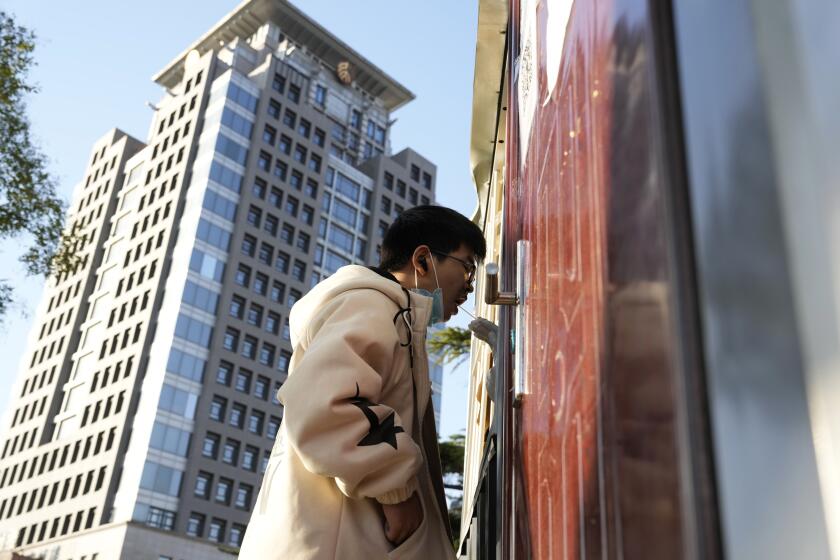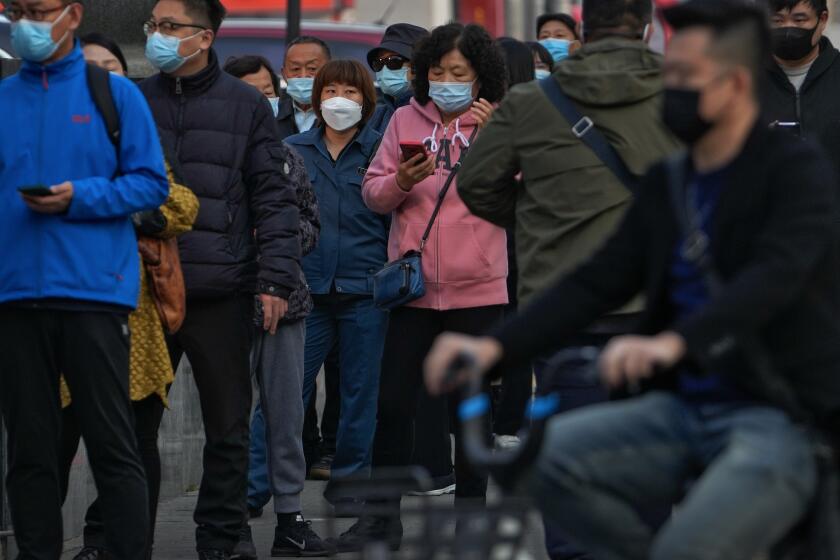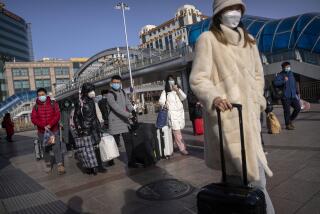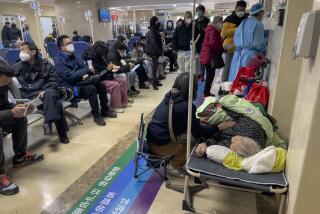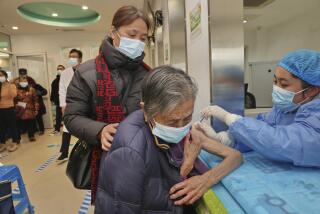China expands lockdowns as COVID-19 cases hit a daily record
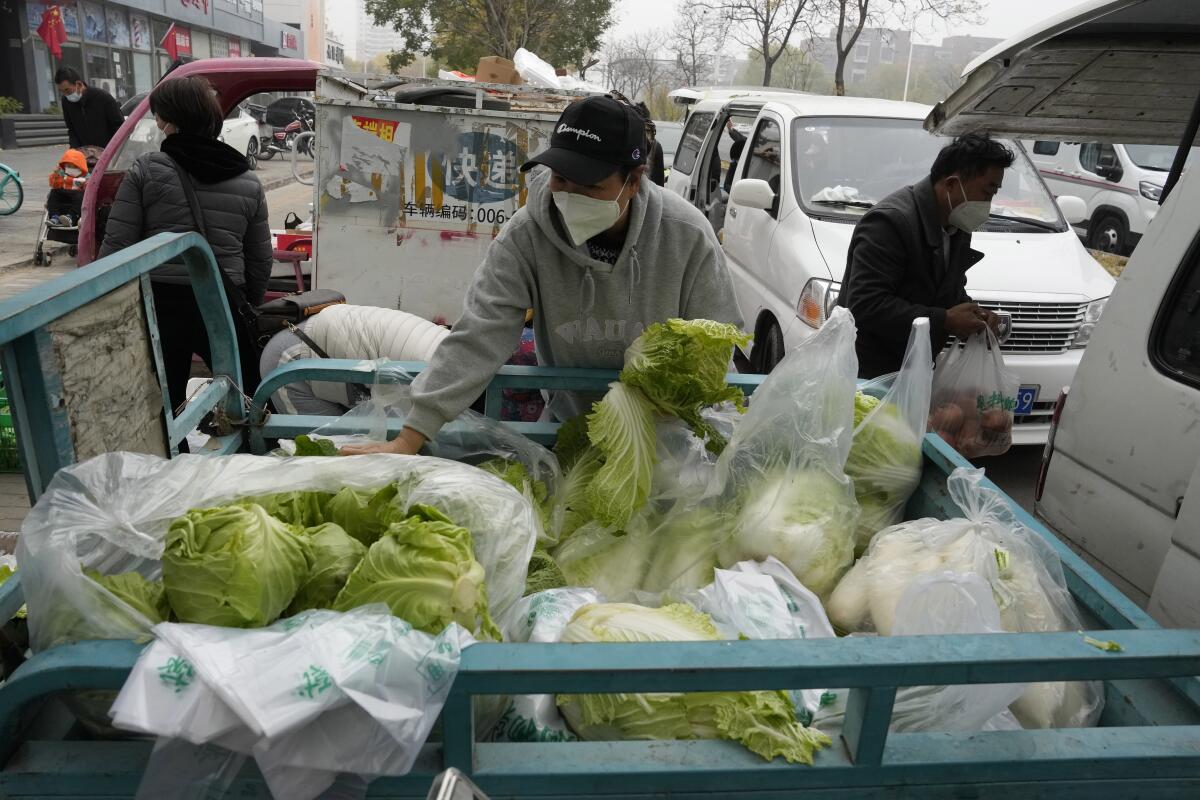
- Share via
BEIJING — Coronavirus lockdowns are expanding across China, including in a city where factory workers clashed this week with police, as the number of COVID-19 cases hit a daily record.
Residents of eight districts of Zhengzhou, home to 6.6 million people, were told to stay home for five days beginning Thursday except to buy food or get medical treatment. Daily mass testing was ordered in what the city government called a “war of annihilation” against the coronavirus.
During clashes Tuesday and Wednesday, Zhengzhou police beat workers protesting over a pay dispute at the biggest factory for Apple’s iPhone, located in an industrial zone near the city. Foxconn, the Taiwan-based owner of the factory, apologized Thursday for what it called “an input error in the computer system” and said it would guarantee that pay matched the level agreed to and advertised in official recruitment posters.
In the previous 24 hours, the number of new COVID-19 cases rose by 31,444, the National Health Commission said Thursday. That’s the highest daily figure since the coronavirus was first detected in the central Chinese city of Wuhan in late 2019.
The daily caseload has been steadily increasing. This week, authorities reported China’s first COVID-19 deaths in six months, bringing the total to 5,232.
While the number of cases and deaths is relatively low compared to the U.S. and other countries, China’s ruling Communist Party remains committed to a “zero-COVID” strategy that aims to isolate every case and eliminate the virus entirely. Most other governments have ended coronavirus controls and now rely on vaccinations and immunity from past infections to help prevent deaths and serious illness.
Pfizer said its updated COVID-19 booster may offer some protection against newly emerging Omicron subvariants, even though it’s not an exact match.
Businesses and residential communities from the manufacturing center of Guangzhou in the south to Beijing in the north are in various forms of lockdown, particularly affecting blue-collar migrant workers. In many cases, residents say the restrictions go beyond what the national government allows.
Guangzhou suspended access Monday to its Baiyun district of 3.7 million residents, while in some areas of Shijiazhuang, a city of 11 million people southwest of Beijing, residents were told to stay home while mass testing is conducted.
Beijing opened a hospital in an exhibition center. It suspended access to the Beijing International Studies University after a coronavirus case was found there. Some shopping malls and office buildings were closed, and access was blocked to some apartment compounds.
Suggesting that some of those measures might be at least semi-permanent, workers were erecting a 7-foot-tall fence around the aging, low-rise brick apartment buildings in Beijing’s Hongmiao Beili community.
Students and faculty at Peking University were not allowed to leave the grounds unless necessary, and classes were moved online through Friday.
A half-dozen people in hazmat suits manned the entrance to a lane running through the community, standing behind waist-high steel barriers usually used for crowd control.
Authorities had announced measures to try to reduce disruptions from pandemic controls by shortening quarantines and making other changes. Some Chinese have expressed frustration and confusion about the apparent policy flip-flops on social media.
While China’s borders remain largely closed, the government has been “optimizing and facilitating the exit and entry process for executives and specialized personnel of multinational companies and foreign businesses and their family members in China,” Foreign Ministry spokesperson Mao Ning said at a news conference Thursday.
Mao said China would continue to improve various COVID protocols “according to the science-based and targeted principles” to help facilitate travel and cooperation and exchanges with other countries.
A key issue is concern about how vulnerable people are to the coronavirus. Few Chinese have caught COVID or even been exposed to the virus, so only a small percentage are thought to have built up effective levels of virus-fighting antibodies naturally.
China has an overall COVID-19 vaccination rate of more than 92%, with most people having received at least one dose. But far fewer older Chinese — particularly those over age 80 — have gotten the shots.
The government is trying to contain the latest wave of outbreaks without shutting down factories and the rest of its economy as it did in early 2020. One tactic is using “closed-loop management,” under which workers live in their factories with no outside contacts.
Foxconn, the world’s biggest contract assembler of smartphones and other electronics, is struggling to fill orders for the iPhone 14 after thousands of employees walked away from the factory in Zhengzhou last month following complaints about unsafe working conditions.
China’s largest city, Shanghai, has started administering an aerosol COVID-19 vaccine that recipients suck in through their mouths, state media said.
The protests on Tuesday and Wednesday were driven by disagreements over payment of workers who were recruited to replace those who left. Workers scuffled with police and some were beaten. Some were arrested.
Foxconn denied what it said were comments online that employees with the coronavirus lived in dormitories at the Zhengzhou factory. It said facilities were disinfected and passed government checks before employees moved in.
More to Read
Sign up for Essential California
The most important California stories and recommendations in your inbox every morning.
You may occasionally receive promotional content from the Los Angeles Times.

